Every year I typically get about a week to go off on a solo birding trip. Earlier this year I was contemplating where to go and basically decided on either Colorado or southern Florida in April. I had never birded in either location; so many lifers awaited me in both places. So I asked another birder for his recommendation. He told me there was absolutely no choice – I had to go to Colorado!
I scheduled the trip for April 14-25. I would have a week on my own, and then my wife would join me on the 21st. We would do mostly non-birding stuff together, with a little birding thrown in at some places I couldn’t fit into my first week. My attack plan was fairly simple. I decided to do a huge, counter-clockwise tour of the state. I would fly into Denver and immediately head west for the White-tailed Ptarmigan. Then I would travel to the northwest corner for the first of the lekking grouse, and then continue down through Gunnison to the southeast corner. Finally, I would head up to the northeastern area, and then back to Denver to pick up my wife.
My main targets were, of course, the grouse and chickens. But there were plenty of others also. A conservative list of possible lifers came out to 27! Of course, I wasn’t expecting to get them all, but I was hoping for at least 17, for that would give me 500 for my ABA list (all in the lower 48 states).
But first, some general recommendations:
- Drive a high-clearance, four wheel drive vehicle! Most days I didn’t absolutely need it. But most of the birding is done from gravel roads. I was fortunate to not have much rain, but they could get treacherous if wet. Also, there is still snow in the higher altitudes. There were some areas that I would not have been able to get to in a normal car. These cars are also usually higher and give you a better view. This is important at some of the grouse leks. At some of them (especially at Gunnison and Campo) those seated lower might not be able to get a good look at the birds. Of course, the downside is that I had to get gas every day (or at least it seemed that way).
- I did not make reservations any more than one day in advance. I wanted to remain as flexible as possible so that if I missed some targets I wouldn’t necessarily be forced to skip them completely. The only exception I made was signing up for the Greater Prairie-chicken tour through the Wray Chamber of Commerce, which included accommodations for the night. However, this policy almost cost me dearly in Springfield. Springfield has the closest accommodations to the Lesser Prairie-chicken lek near Campo. But it is a very small town with only three motels. The first two I tried were full (mostly with other birders). Thankfully the last one had a room for me. Thus, if possible I would very highly recommend securing a reservation there well in advance.
Resources used:
- ABA’s A Birder’s Guide to Colorado: This is out-of-print, but I scored one from a small online retailer. It has excellent maps and was generally helpful. But it is a little out of date, and with the excellent online resources available is not strictly necessary.
- COBirds email listserv
- cobirders email listserv: both of these listservs were very helpful
- Colorado Field Ornithologists: very nice website with directions to many birding locations
- Colorado Birding Society: also has directions to sites, and is regularly updated with recent sightings. Has a very good page on grouse.
Lifers are in bold
Day 1 – April 14, 2007
I landed safely at Denver and left the airport around 2:30. I headed west on I-70 toward Loveland Pass where some White-tailed Ptarmigan had been reported. The ptarmigan was one of my most-wanted targets of the trip, so much so that even if it was the only bird I saw the entire day, it would still be a success. But first I stopped at Genesee Park, which is just off the interstate west of Denver. I was specifically looking for a Williamson’s Sapsucker that had been reported around the group picnic area. I didn’t know exactly where the group picnic area was, so I first checked out the portion of the park on the north side of the interstate. I didn’t see anything promising there, so I headed up to the upper part of the park on the south side of I-70. Eventually I found an area with some picnic tables so I parked and walked around a while. I didn’t find the sapsuckers, though. I did see my first Dark-eyed Junco of the Gray-headed subspecies, along with a Cooper’s Hawk, Western Bluebirds, Pygmy Nuthatches, a Red Crossbill, and Pine Siskins. I wanted to make sure I had plenty of time to search for the ptarmigans, so I had to leave after an hour.
The usual spot for the ptarmigans in winter is Guanella Pass.
However, this year the county did not plow the road and it was
therefore inaccessible. But there had been some reports of them at
Loveland Pass. The latest one reported two birds among the willows
southeast of the parking area. I got up to the parking area at
5:30 and immediately started scanning southeast (downhill) of the
parking lot. But I couldn’t figure out exactly where the report
meant. So I just scanned the entire area with binoculars and
scope, focusing on the rocky areas. But it’s a fairly large area
and after several minutes of fruitless scanning I was starting to
get frustrated. But then I spotted one, and then a second, bright
white spot among some rocks nearby.
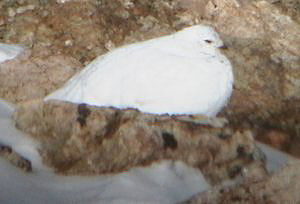 In the scope they resolved
into two White-tailed Ptarmigans! They
were sitting motionless on the ground right out in the open about
75 yards distant. They would be nearly invisible against the snow.
But thankfully they were among the rocks, which provided a little
bit of contrast. You could see them as bright white spots with the
naked eye, and could recognize them as ptarmigans with binoculars.
But with the scope you could make out their black eyes and bills.
Otherwise they were just little white fluffballs.
In the scope they resolved
into two White-tailed Ptarmigans! They
were sitting motionless on the ground right out in the open about
75 yards distant. They would be nearly invisible against the snow.
But thankfully they were among the rocks, which provided a little
bit of contrast. You could see them as bright white spots with the
naked eye, and could recognize them as ptarmigans with binoculars.
But with the scope you could make out their black eyes and bills.
Otherwise they were just little white fluffballs.
After that wonderful success, I continued west to Dillon to spend the night. But first I checked out the Dillon Reservoir, which was frozen over. Not many birds, but I did see a Coyote walking across the lake.
Day 2 – April 15, 2007
Today I made my way to Craig, where I was going to spend the next two nights. Driving north on Hwy 9 from Dillon I started seeing Black-billed Magpies along the road. These, along with American Kestrels, seem to be just about everywhere in the state. I took a detour around Green Mountain Reservoir, but the water seemed to be very low so I didn’t see anything on the lake. At one of the stops there I found a Song Sparrow, which surprisingly turned out to be the only one I saw on the entire trip.
The next stop was in Kremmling, where I was hoping to get some rosy finches at a feeder in town. I made my way to the intersection I had seen in some reports – but no feeders. Disappointed, I continued on to a spot where I could get a clear look at the “Kremmlin’ Wall” – a huge cliff beyond the town. I had read that rosy finches could sometime be seen on it. But if there were any there, I was way too far away to see them! But as a consolation, I did spy a beautiful Golden Eagle perched on the top of the cliff. I’ve looked for these majestic raptors in several states but hadn’t happened across one. So even though I was fully expecting to see one on this trip it was still somewhat of a relief.
Continuing north on Hwy 40 I made a quick stop at Hinman Reservoir. There wasn’t anything too exciting – a pair of Western Grebes, some Common Mergansers, and a couple other waterfowl species.
The next stop few stops were along the Rabbit Ears Pass area where
the highway crosses over the Continental Divide and there is some
nice higher elevation habitat. The snow was too deep here to do
any hiking away from the road, so my plan was just to stop at
every parking area and see what I could find. The first parking
area was at the sign for the Continental Divide, right on the
Grand/Jackson county border. Immediately after stepping out of the
car I could hear some activity on the opposite side of the road.
There was a small bird flying between the very tops of the
conifers. I was very surprised to find that it was a male
White-winged Crossbill!
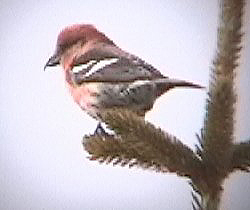 These nomadic
finches are rare in the state. I had seen some reported from
another mountain pass, but this was definitely a species I had not
been planning on seeing. There was at least one male and one
female/immature bird. I was able to get the male in the scope long
enough to make sure I wasn’t deluding myself. The crossed bill was
undeniable. They were roaming all around the area along with a
Gray-headed Junco and a single Gray Jay.
These nomadic
finches are rare in the state. I had seen some reported from
another mountain pass, but this was definitely a species I had not
been planning on seeing. There was at least one male and one
female/immature bird. I was able to get the male in the scope long
enough to make sure I wasn’t deluding myself. The crossed bill was
undeniable. They were roaming all around the area along with a
Gray-headed Junco and a single Gray Jay.
I made several more stops in the next couple of miles and found
some Pine Siskins, Red Crossbills, and a single Mountain
Chickadee. Another unexpected sighting occurred at the parking
area for the West Summit. As soon as I got out of the car I heard
drumming from across the street, followed by a woodpecker’s “pick”
call. I was really hoping it would be a three-toed woodpecker, but
was fully expecting it to be a Hairy.
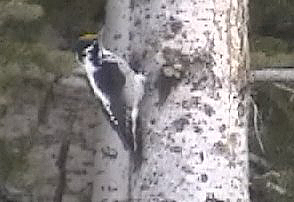 I soon saw the bird hitch up
a tree from behind the high snow bank directly opposite me.
It was in fact a male American Three-toed Woodpecker.
It flew to a couple of different trees, staying
fairly close to the ground. I was able to cross the road and get
some good video of it before it disappeared deeper into the woods.
I’m glad it was a male with an obvious yellow crown, because I
didn’t see the barring on the back or the flanks until I watched
the video. If it had been a female I could have very easily passed
it off as a Hairy. This elusive woodpecker was on my target list
but I honestly didn’t think I would see one.
I soon saw the bird hitch up
a tree from behind the high snow bank directly opposite me.
It was in fact a male American Three-toed Woodpecker.
It flew to a couple of different trees, staying
fairly close to the ground. I was able to cross the road and get
some good video of it before it disappeared deeper into the woods.
I’m glad it was a male with an obvious yellow crown, because I
didn’t see the barring on the back or the flanks until I watched
the video. If it had been a female I could have very easily passed
it off as a Hairy. This elusive woodpecker was on my target list
but I honestly didn’t think I would see one.
I continued on to Craig without any further stops. It was only 12 something and too early to check in to the hotel. The only thing I definitely wanted to do was scout out the grouse leks on 20 Mile Road for the next morning. So I continued through Craig and headed to the Oxbow Wildlife Area where I was hoping for Sage Thrasher and Sparrow. After driving what seemed like forever I stopped to check the map and directions. It turns out that I hadn’t read the directions very well and had overshot the place by about 15 miles. Oops. Backtracking, I finally made it to the small parking area. A Western Meadowlark was there to greet me. I started walking the trail down to the oxbow lake and hadn’t gone very far before a dark-ish bird flushed up. It landed on a distant bush and proved to be a Sage Thrasher. One down… A little ways further along I started to hear some “tick” calls. A bird then flushed up and also landed on the top of a bush. Only this time it was a Sage Sparrow. It remained there, perched out in the open, long enough for me to get a great look at it. The blue of the head was a very beautiful, subtle shade that contrasted strongly against the brown back. For a time I thought that it might be my favorite looking sparrow. Or at least it was until I saw a Black-throated Sparrow later on in the trip that reminded me that it still held the top position. At the lake itself were several waterfowl including Gadwall, Green-winged, Blue-winged and Cinnamon Teal, and Ring-necked Duck. With them was a single Sandhill Crane, and a male Northern Harrier was hunting overhead.
Back in Craig I checked into the hotel and then headed out to 20 Mile Road (just east of Hayden) to check out the locations of the Sharp-tailed Grouse leks. I thought I had found the correct spots, but as I was reviewing the directions later that night I figured out that I had not. As I returned to the hotel at 8:30 I heard the winnowing flight display of a Wilson’s Snipe.
Day 3 – April 16, 2007
I began the day on Twenty Mile Road, southeast of Hayden, looking for Sharp-tailed Grouse. The directions to the leks were a little confusing. They said to go past the large pond on the right (about 5.4 miles from 40), and continued about a mile. They mentioned something about an old gate on the left, and that the lek would be across the street. I did find a gate on the left about a mile past the pond. I parked there a little after 5:30 and listened. The lek was supposedly on the opposite (west) side of the road. I did hear some grouse from that direction, but could never see them as it became light. The constant truck traffic was incredibly annoying and didn’t help matters. But there was another lek mentioned, 8.6 miles from 40. You turn off to the right onto an old section of the road. I did not find such a place at 8.6 miles, but there was one at around 7.8 miles. Just past the crest of a hill there was a short dirt track that led to the right and paralleled the road for about 50 yards or so. I parked there around 6:30 and immediately heard some grouse. Scanning, I finally spotted a Sharp-tailed Grouse. I broke out the scope and found at least ten of them. Their display is just incredible! The birds themselves don’t have the odd visual qualities that the sage-grouse and prairie-chickens possess. But they more than make up for it in their behavior. Their foot stomping and scurrying about was simply hilarious.
Leaving there about 7:15, I headed toward CR-80 to see if I could find any displaying grouse there. I drove past the Jim Dunn Gulch sign without seeing any grouse whatsoever. On the way back, though, I did see three Greater Sage-Grouse displaying to the west. I only got a quick, distant look at them because a DOW official pulled up at that moment. He wanted to see if I was a birdwatcher since he leads tours to the grouse leks. I’m glad I ran into him because he told me the sage-grouse lek here would probably be better than the Timberlake Lek that I was planning on visiting the next morning. The grouse had moved off while we were talking, sometime around 8:15. On my way out I did find the Dusky Grouse at the second cattle guard. He was on the east side, just inside the trees. He called a couple of times and displayed his air sacs, and then went on foraging deeper into the trees.
Last night I had looked online for some other sites in the area to bird. I found two promising places north of Craig – Cedar and Black Mountains. I went to Cedar Mountain next. The CFO website promised that it was a reliable spot for Pinyon Jays. They were not mistaken. I drove up the road past the information sign and picnic area and parked where the road split. A word of warning, a high clearance four wheel drive vehicle is required!! I heard some jays there and eventually spotted some higher up. I climbed the trail after them and got good looks at six Pinyon Jays. A single Rock Wren was singing among the rock at the top of the ridge.
After a lunch break I headed up Hwy 13 to Black Mountain, part of the Routt National Forest. To get there you turn right on CR 27 and proceed 10 miles up the dirt road to the national forest. I was hoping to get some of the high elevation birds that I still needed, but it was not meant to be. Starting at about 8 miles portions of the road were covered with snow. About half a mile further it proved impossible to continue. A quick walk around found Downy and Hairy Woodpeckers, flickers, a Black-capped Chickadee, two female Cassin’s Finches, and many Dark-eyed (Gray-headed) Juncos. Most frustratingly, I could hear some sapsuckers drumming in the distance, but couldn’t spot any (Williamson’s Sapsucker is still among my targets).
From there I continued north on Hwy 13 toward the Timberlake Lek area. I no longer needed to scout the area for the next day, but thought I’d go anyway. On the way I saw a sign for another access road to the national forest (CR 38). I figured I’d give it another shot. But again, about three quarters of the way to the forest I ran into insurmountable snow in the road.
I was hoping to see some sage-grouse along CR 3 and the dirt track that leads to Timberlake Lek. That didn’t happen, but I did flush up a Sage Thrasher and Sage Sparrow along the dirt track. Those sparrows seem to have an agreeable habit of perching on the top of a bush after flushing. Other new birds for the trip were a Horned Lark and a Merlin that zoomed past.
Day 4 – April 17, 2007
Originally I had planned to try for lekking Greater Sage-grouse at the Timberlake Lek, north of Craig. However, the DOW official I ran into yesterday told me that lek had been very inconsistent lately and that the one on CR-80 was a much better bet. So I headed back to CR-80 and was parked opposite the lek by 6:05. I could hear the birds and after it got light enough I could see at least 13 of them. 10 were definitely males, and I think there were also three females. I was the only person there, so I setup my scope using the car as a blind so that I could get a better look at the grouse. I was careful to make as little noise as possible and to always enter and exit the car from the side away from the birds. The display was incredible. Unfortunately it was very overcast and foggy so I didn’t get very good pictures or video. It was also a chilly 35 degrees. While watching the sage-grouse I had two Sharp-tailed Grouse fly by and I heard another one. I left the lek around 7:30, before the grouse did. That didn’t appear to disturb them, and hopefully that was truly the case. I did not see the Dusky Grouse on my way in or out.
I made my way back to Craig and checked out of the hotel. Then I headed south on Hwy 13. I was headed toward Gunnison with a couple of planned stops along the way. Just south of Craig an immature Bald Eagle flew over the road.
I made it to Coal Canyon in Cameo by 11am. My target here was the introduced Chukar. I spent two and a half hours walking this canyon but could not spot one. I heard several, and even got a few to respond to playback, but I just couldn’t see one. I know I could count those according to the ABA guidelines, but I personally don’t add a bird to my life list until I’ve seen it. I also heard Rock and Canyon Wrens and saw the aforementioned Black-throated Sparrow.
I stopped at Confluence Park in Delta just to see what was there. That turned out to be not much. I was unaware of the Ross’s Goose that had been reported from there and either missed or overlooked it.
Next up was Fruit Growers Reservoir. There were a good many birds on the water. New ones for the trip included Pied-billed Grebe, Northern Pintail, and Redhead. An Osprey stood watch on a snag, and a Ring-necked Pheasant was seen among the brush just before the water.
From there I continued directly to Gunnison. I checked in and had some dinner at a fantastic local Italian place (Mario’s, I think). I still had some light, so headed up to the small town of Crested Butte, about 20 miles north of Gunnison. A lady in town there has had all 3 rosy finches and Evening Grosbeaks coming to her feeders. They seem to be very hit-or-miss and mostly come in bad weather. The weather didn’t seem promising for them, but it couldn’t hurt to try. I watched the feeders for 20 minutes or so, but didn’t see anything except for some Pine Siskins and Red-winged Blackbirds. I spoke to the owner for a minute and she said that morning was generally the best time. So I planned on going back the next morning immediately after visiting the Gunnison Sage-grouse lek.
Day 5 – April 18, 2007
The Waunita Hot Springs watchable wildlife site east of Gunnison
is the best spot in the state (and maybe anywhere?) to see the
Gunnison Sage-grouse. Due to the many visitors at this site, it is
even more important to follow the grouse lek etiquette. Therefore
I arrived at 5:15, well before official sunrise. There was a small
tour group already there in the portable blind. It was very cold,
about 24 degrees, so I did not mind having to stay in the car! As
expected, the grouse could be heard well before they could be
seen. But once it was light enough they were easily spotted
through binoculars. They were maybe 100 yards from the road – just
far enough that they couldn’t really be seen with the naked eye.
But they were clearly visible with bins and definitely with a
scope. I didn’t have a window mount for the scope, but I was able
to improvise and propped it on the door using a shirt for padding.
It worked pretty well to view them, but it made getting good
digiscoped pictures and video a little tough.
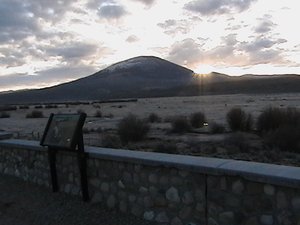 There were 23
Gunnison Sage-grouse in total. The
filoplumes were indeed thicker and more obvious than those on the
Greaters, just as advertised. The grouse left in two groups. The
first flew off before official sunrise, and the second group of
about 11 birds left at 6:35. This was a lot earlier than I had
been expecting.
There were 23
Gunnison Sage-grouse in total. The
filoplumes were indeed thicker and more obvious than those on the
Greaters, just as advertised. The grouse left in two groups. The
first flew off before official sunrise, and the second group of
about 11 birds left at 6:35. This was a lot earlier than I had
been expecting.
After checking out of the hotel I headed north back to Crested Butte. I arrived a little past 8 and stayed for a little over an hour. The same birds as last night were present, as well as a couple of Cassin’s Finches. I was beginning to think it was going to be a dud when I spotted a new bird that had snuck onto the feeder platform. It turned out to be a female Brown-capped Rosy-finch. It was later joined by a male. The only American Goldfinch of the trip also put in an appearance, and two Golden Eagles flew over the town.
After leaving the feeders I set out westward toward Pueblo. The next stop was at Tunnel Drive just outside Canon City. A vagrant Golden-crowned Sparrow had been seen there consistently for at least a month. Apparently it liked to hang out with a group of White-crowned Sparrows. Unfortunately, I couldn’t find a sparrow of any kind. But I did get two new trip birds in a male Broad-tailed Hummingbird and some White-throated Swifts flying overhead.
Up next was Lake Pueblo State Park to look for Scaled Quail and whatever else may be about. On my way there I drove around Pueblo West a little bit but didn’t see anything other than a Great-tailed Grackle. Once in the park I found many Black-tailed Prairie-dogs. I had to get out and enjoy them a little bit as I’d never seen one before and have wanted to for as long as I can remember. They have to be one of the most adorable little critters. This also paid off bird-wise, as I found my first Burrowing Owls standing guard over their own burrows amidst the prairie-dogs. I continued down to the North Marina hoping to get a view of the reservoir, and keeping my eyes open for quail. I found myself on the boat ramp with no good spot to scan the lake, so I turned into the parking lot to head back the other way. Immediately I saw two Scaled Quail scampering across the pavement. They made their way underneath a trailer and started foraging with a third quail. Feeling very fortunate to have found my target I started to pull out of the lot when I noticed a lone bird perched still in a row of trees. I was very surprised to find it to be a Townsend’s Solitaire. I wasn’t expecting to find one here, but a local birder later told me that they winter in the park. I guess this one didn’t want to head back up to the mountains just yet. That was very lucky for me, as I was not to see another on the trip.
I eventually found a good place to scan the lake. Another birder was already there and told me that a couple Red-throated Loons had been reported. They are pretty rare in the state, especially at this time of year. I started scanning and found the loon fairly quickly. It was in nice breeding plumage (apparently there was also a second bird in basic plumage). I only saw it a couple times as it was diving quite frequently. There were also many Western Grebes, Ruddy Ducks, and gulls that were too far out to ID for certain. Seven American White Pelicans could be seen far across the lake.
Originally I had planned on staying in Pueblo tonight, but I still had plenty of daylight left, so I decided to continue toward the southeast corner of the state. I figured I could hit a couple of sites and then spend the night in Lamar.
I still needed a Franklin’s Gull and Clark’s Grebe, so I make my way to Lake Henry and Lake Meredith. I had been told I should be able to see them there. I was not disappointed. Lake Henry was up first. Despite very strong winds I found some Clark’s Grebes and Franklin’s Gulls. I was able to get very good looks at them and noted all the various field marks that differentiated them from Western Grebes and Laughing Gulls, respectively. There were also a few new trip birds in Pied-billed Grebe, Lesser Scaup, and Bonaparte’s Gull.
I also tried Lake Meredith, but the wind was so strong it was forming waves that were actually breaking on the shoreline. But I did come across a large blackbird flock containing Red-winged, Brewer’s, and Yellow-headed Blackbirds. The latter were the only ones I was to see on this trip.
I had been told the marshes around Ft Lyon were really good for owls and rails. I would actually be in the area around sunset, so I gave it a shot. I found the first spot mentioned and played the songs for Sora and Virginia Rail. But the wind was so strong that if any were there I doubt they could hear it. I certainly couldn’t hear them. I drove to the second spot and tried again. This was at the large marsh at the bend in the road at the intersection of CR-HH and CR-16. There I heard both Sora and Virginia Rail. I also tried to tape in a Western Screech-owl from the row of trees along the road, but the wind again made it very difficult. After a couple of tries I decided it was probably a waste of time.
For some reason rooms were scarce in Lamar. I finally got one at the fourth place I tried. But it was cheap and had wireless internet access, so I was content.
Day 6 – April 19, 2007
After the seven lifers I had yesterday my ABA total was now at 499. Some possibilities for the milestone were Lewis’s Woodpecker and Juniper Titmouse at Cottonwood Canyon. I’d love for it to be the Lewis’s, but the titmouse would also be strangely appropriate as my 300th bird was a Bridled Titmouse. Or perhaps it would be a Barn Owl at Two Buttes? I just haven’t yet managed to get a good enough view of this species to be able to count it.
First up was Two Buttes. No lifers, but I did get several new trip birds. I scanned all the cliffs carefully for Barn Owls, but didn’t find any. I did, however, find a roosting Great Horned Owl. In the passerine department I encountered Ruby-crowned Kinglet, Blue-gray Gnatcatcher, Loggerhead Shrike, Orange-crowned Warbler, Yellow-rumped Warbler (both Myrtle and Audubon’s), and Lark Sparrow. On the way out I found a single Wild Turkey walking across the road over the dam.
Next stop was at Springfield for lunch and to find a room for the night. I finally found a room at the third place I tried. There are only three motels in the town, so I was a little worried! But it worked out alright.
After lunch I made my way to Cottonwood Canyon. I had heard some very good things about this place. But I have to say that it was disappointing. It was very pretty, don’t get me wrong. But there didn’t seem to be many birds about. Maybe I was just there at the wrong time (it was mid-afternoon after all). I was especially disappointed not to find a Lewis’s Woodpecker. I had been counting on one here. On the other hand, I did see a few species here that I wouldn’t see elsewhere, specifically Ladder-backed Woodpecker, Bewick’s Wren, and Canyon Towhee. There was also a group of Wild Turkey right next to the road that included a huge tom that was fully puffed up in display.
At the canyon I met a pair of birders from England. They mentioned that there haven’t been many Lesser Prairie-chickens on the lek. They had been at the lek that morning and only had one bird. The single male came in very late, after another group of birders had given up and left. That wasn’t welcome news. I was planning on scouting out the lek in the evening anyway, so I decided I would wait around to see if a chicken showed up at sunset so as to maximize my chances of seeing one. I got to the lek at 5:25 and ran into a car full of birders doing the exact same thing. Sunset wasn’t for another two hours so I contemplated driving around some to see if I could find anything else. In the end I decided to just stay put. I was tired of driving and I didn’t want to chance missing the chicken. So I just grabbed a book and waited. Cassin’s Sparrows and Western Meadowlarks serenaded us while we waited. Official sunset passed without incident. I put down the book and started watching carefully just in case. At 7:50 a single Lesser Prairie-chicken flew onto the lek. Shortly thereafter it started displaying. I could clearly see the raised pinnae feathers, but the failing light and the bird’s location kept me from seeing many details. But I could clearly hear it. The two-noted call was very different from the Greaters. There was also a good bit of cackling. It stayed 24 minutes and then flew off. Not a bad bird for #500!
Apparently the Lessers are not doing very well in Colorado. During the past winter there was much more snow than usual and it remained for longer than normal. There are concerns on how that affected the chickens. To make it even more difficult it seems that most of the chickens have abandoned this well-known lek. This single male apparently has not, but other chickens have been heard from somewhere nearby. I know that some birders had looked for them but as far as I know they had not been found.
Day 7 – April 20, 2007
Originally I had planned on spending this morning at the Lesser Prairie-chicken lek. But since that male was so obliging the night before I decided I could sleep in. I had to attend an orientation in Wray for the Greater Prairie-chicken tour at 7pm, so that gave me plenty of time to make some stops along the way.
On my way north to Lamar I saw a couple of raptors perched on utility poles. One got me hoping for a Rough-legged Hawk. It had a small bill and a round, pale head. There was a hint of a dark eye-line. I had parked the car on the side of the road and had turned away to grab my scope, but when I turned back around the hawk had disappeared. Looking through some guides later I’m sure it was either a Rough-legged or Swainson’s, but I’m not sure which. All the other raptors seen were definitely Swainson’s.
The first stops of the days were at a couple reservoirs in Kiowa
county. First up was Neenoshe. On the gravel county road
approaching the reservoir I found an immature Ferruginous Hawk perched on a utility pole. After
reaching for the video camera it too had disappeared. I scanned
the sky for it and eventually found it flying over the field. The
“three points of light” on the upperside (the white patches near
the primaries and the base of the tail) were very obvious.
Continuing on to the lake I found that the water level seemed very
low. There was no way I could see anything on the water or the
water’s edge. Along the row of trees along the road I found just a
few birds such as Vesper and Lark Sparrow. On the way out a pair
of Ring-necked Pheasants put on a show in the middle of the field.
A little further along I thought I saw something right by the side
of the road.
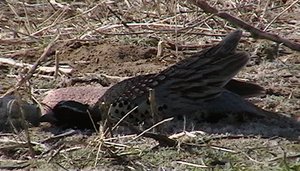 It turned out to be another pheasant lying down on
the ground, all stretched out in the shadow of a utility pole. It
appeared to be playing dead. I never saw it move, so I assume it
was just acting and not, in fact, actually deceased.
It turned out to be another pheasant lying down on
the ground, all stretched out in the shadow of a utility pole. It
appeared to be playing dead. I never saw it move, so I assume it
was just acting and not, in fact, actually deceased.
After checking the map I realized that I had passed the road leading to the Upper Queens Reservoir. So I back tracked about a mile and turned on the road toward that lake. Not too far down the road I came across a couple of groups of Long-billed Curlews (5 birds total). Luck was on my side as they were right beside the road. On my way back out I didn’t see any. At the reservoir itself I found a single Semipalmated Plover, 5 American Avocets, and 18 White-faced Ibis.
I didn’t make any other stops until Bonny State Park, as I wanted to have plenty of time there. I was really hoping to find a roosting Long-eared Owl, as I had seen several trip reports that mentioned them. But it was not meant to be. I scanned every tree, especially the conifers, all along the park but did not find any. I did get a couple of new trip birds in Red-bellied Woodpecker, Cedar Waxwing, and Blue Jay.
I got to Wray in plenty of time to get some dinner and check-in to the motel. As I was walking to the museum for the orientation I saw some Chimney Swifts overhead, the only ones I would see on the trip. The orientation was fun and got me excited about the next morning, even though it would be the earliest of the trip.
Day 8- April 21, 2007
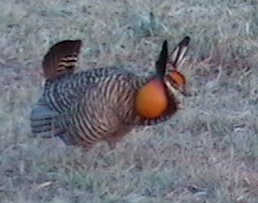 We met the school bus in the motel parking lot at 4:35. It
transported us to a Greater Prairie-chicken lek at a nearby ranch.
The DOW had one of the portable blinds setup there. The weather
was absolutely amazing. It was clear, calm, and in the 60’s! From
what we were told the night before it could have been much worse.
I had previously seen the Attwater’s subspecies of this bird in
Texas. But the blind had been about 100 yards from the lek. You
could see them ok, but couldn’t really hear the birds. Not so
here. Before it was light we were surrounded by the deep, eerie
sounds of these chickens along with their fantastic cackling
noises. As dawn broke we could see them all around us. A few
approached within ten feet or so of the blind, but most kept a
little further away. But the spectacle was truly amazing. We
counted 25 birds altogether, at least one of which was a female.
This was by far the best overall experience at the various grouse
and chicken leks. Also at the lek were a few Western Meadowlarks
and six Burrowing Owls.
We met the school bus in the motel parking lot at 4:35. It
transported us to a Greater Prairie-chicken lek at a nearby ranch.
The DOW had one of the portable blinds setup there. The weather
was absolutely amazing. It was clear, calm, and in the 60’s! From
what we were told the night before it could have been much worse.
I had previously seen the Attwater’s subspecies of this bird in
Texas. But the blind had been about 100 yards from the lek. You
could see them ok, but couldn’t really hear the birds. Not so
here. Before it was light we were surrounded by the deep, eerie
sounds of these chickens along with their fantastic cackling
noises. As dawn broke we could see them all around us. A few
approached within ten feet or so of the blind, but most kept a
little further away. But the spectacle was truly amazing. We
counted 25 birds altogether, at least one of which was a female.
This was by far the best overall experience at the various grouse
and chicken leks. Also at the lek were a few Western Meadowlarks
and six Burrowing Owls.
We stayed until 7:30. We were then taken to a ranch house where we were fed a great breakfast of pancakes, bacon, and scrambled eggs. It was a great end to a great morning. This tour is highly recommeded!! For more info on this tour visit the Wray Chamber of Commerce website.
I then headed back toward Denver to pick up my wife. We were planning on doing some stuff in Denver and then heading up to Fort Collins. That would be our base for a couple of days to explore Rocky Mountain National Park and Pawnee National Grassland.
We both love baseball, so we have to attend a game wherever we go. This evening we watched the Rockies get beat by San Diego. But it was a very nice ballpark. And the 16th Avenue Mall in downtown Denver was also impressive. We wish that Atlanta had something similar.
Day 9- April 22, 2007
We started the day at the Denver Zoo. We greatly enjoy zoos, and this one is perhaps the best that we’ve been to. They have a surprisingly good collection of birds. There were also a few wild ones about. I was surprised to spot a Black-crowned Night-heron up in a tree. Later we saw several more, along with many Double-crested Cormorants, on the island in the middle of the duck pond. According to a zoo employee we talked to this is the largest breeding colony in the state for both species.
After checking in to our hotel in Fort Collins we decided to go ahead and scout out the national park. It took much longer to get there than I was expecting. Once there, we drove up Trail Ridge Road as far as we could. The road was closed at Many Curves. And we checked out a few other places. Not many birds about, but we did see many Elk, a couple of Mule Deer, and one Abert’s Squirrel.
Day 10- April 23, 2007
The weather report for the next few days didn’t look promising. It looked like lots of rain. So I wanted to bird the Pawnee National Grassland while I still could. The rain held off, but it was very windy. My main targets were Mountain Plover and Chestnut-collared and McCown’s Longspurs. I was very thankful for the detailed information on previous plover sightings on the Colorado Birding Society’s website. The second spot we tried was the intersection of 14 and CR-65. I had pulled off on the south side of 14 at a gate and started scanning the fields on that side of the road. Of course there were several Horned Larks and Western Meadowlarks that teased me. But shortly I saw a flash of white fairly close by. I broke out the scope and found that it was indeed a Mountain Plover.
We made a quick drive through Crow Valley Campground, but didn’t see too much. From there we headed to Murphy’s Pasture. We had gone only a short distance before finding our first male McCown’s Longspur on the road. We came across several more males and a few females. I looked for Chestnut-collared where the grass got a little taller, but didn’t find any. We also tried for them along the first mile of CR-65 north of 14, but no luck there either. We were starting to get hungry and still wanted to go back to the national park, so I had to leave the Chestnut-collared for some other time.
We wanted to do a little hiking at the park today, especially around Bear Lake. But the weather did not look promising while driving up to the park. It was lightly raining in Estes Park. As we ascended toward Bear Lake it started changing into freezing rain/sleet. When we got to the Bear Lake parking lot it changed into snow. We immediately saw that any hopes of hiking were gone. Even if it wasn’t currently snowing we couldn’t tell where the trail was! It was covered over with at least six feet of snow. We were able to make our way to the lake itself, but that was it. Apparently, the view is spectacular in summer with the lake and the mountain peaks in the distance. But at the time the lake was frozen solid and with the cloud cover we couldn’t even tell we were in the mountains. But it was still a beautiful scene with the snow falling. With the weather so uncooperative we weren’t able to do anything else in the park except stop at the visitor’s center for some souvenirs. The only birds seen in the park today were a single Common Raven and Gray Jay.
We didn’t have anything else planned, so we checked out North Poudre Reservoir #3, north of Ft Collins. A Surf Scoter had been reported from there recently. They can be found in my home-state of Georgia, but they are the rarest of the three scoters there and I had never managed to see one. The number of birds on this lake was amazing, but I managed to spot the Surf Scoter fairly quickly. There were 13 species of ducks that I was able to pick out, including the first Bufflehead, Hooded and Red-breasted Mergansers of the trip. In addition there were two Common Loons (one breeding and one non-breeding), many Western and Horned Grebes, and a couple Eared Grebes. Five Marbled Godwits and a single Black-necked Stilt were the only two shorebirds, but they were both trip birds.
Days 11 & 12 – April 24-25, 2007
No birding on these days. On the 24th we drove back to Denver. It rained literally the entire day. That wiped out any chance of doing anything at the national park. It also meant I couldn’t chase some rare gulls in Ft Collins. Iceland, Glaucous and Thayer’s Gulls had been reported from the county dump. They had been seen while we were there, but I never had a chance to try for them due to scheduling and the weather.
The night before we were to fly home the Denver area was under a winter weather advisory. But thankfully there wasn’t any snow around the airport and we were able to get home safely.
Summary
Species: 139 (including the heard-only Chukar)
Lifers: 21 (not including those darn Chukars)
Altogether I drove about 2500 miles, most of that in the first week while birding solo. I got a good number of my targets. I missed some of course, but I also saw a couple that I was not expecting. Most importantly I got the ptarmigan and all the grouse and chickens. In hindsight there are a few things I would do differently. Instead of counting on getting the Lewis’s Woodpecker at Cottonwood Canyon, I would have tried harder at a couple of other spots. I also ended up having time to have had a second chance for Chukar at Escalante Canyon. And with some better scheduling (and a foreknowledge of the weather) I probably could have gotten the rare gulls in Ft Collins. Also, I was not able to do any focused owling. It would be very hard for anyone to try for both owls and grouse on a short trip like this. Especially if you also have to drive!
Beside the birds, the state itself was wonderful. The scenery was fantastic, whether it was the mountains, the plains, or the hills and valleys in between.
Overall I consider the trip a success. I definitely enjoyed the state and hope to make it back there sometime. I would greatly encourage other birders to make this trip.
Complete list of species:
Red-throated Loon
Common Loon
Pied-billed Grebe
Horned Grebe
Eared Grebe
Western Grebe
Clark’s Grebe
American White Pelican
Double-crested Cormorant
Great Blue Heron
Black-crowned Night-heron
White-faced Ibis
Canada Goose
American Wigeon
Gadwall
Green-winged Teal
Mallard
Northern Pintail
Blue-winged Teal
Cinnamon Teal
Northern Shoveler
Redhead
Ring-necked Duck
Lesser Scaup
Surf Scoter
Bufflehead
Hooded Merganser
Red-breasted Merganser
Common Merganser
Ruddy Duck
Turkey Vulture
Osprey
Bald Eagle
Northern Harrier
Cooper’s Hawk
Swainson’s Hawk
Red-tailed Hawk
Ferruginous Hawk
Golden Eagle
American Kestrel
Merlin
Wild Turkey
Dusky Grouse
White-tailed Ptarmigan
Greater Sage-grouse
Gunnison Sage-grouse
Sharp-tailed Grouse
Greater Prairie-chicken
Lesser Prairie-chicken
Scaled Quail
Chukar (heard only)
Ring-necked Pheasant
Sandhill Crane
Virginia Rail (heard only)
Sora (heard only)
American Coot
Black-necked Stilt
American Avocet
Semipalmated Plover
Killdeer
Mountain Plover
Wilson’s Snipe (heard only)
Marbled Godwit
Long-billed Curlew
Ring-billed Gull
Bonaparte’s Gull
Franklin’s Gull
Rock Pigeon
Eurasian Collared-dove
Mourning Dove
Great Horned Owl
Burrowing Owl
Chimney Swift
White-throated Swift
Broad-tailed Hummingbird
Belted Kingfisher
Red-bellied Woodpecker
Ladder-backed Woodpecker
Downy Woodpecker
Hairy Woodpecker
American Three-toed Woodpecker
Northern Flicker
Eastern Phoebe
Say’s Phoebe
Horned Lark
Tree Swallow
Cliff Swallow
Barn Swallow
Ruby-crowned Kinglet
Cedar Waxwing
Rock Wren
Canyon Wren
Bewick’s Wren
Sage Thrasher
Western Bluebird
Mountain Bluebird
Townsend’s Solitaire
American Robin
Blue-gray Gnatcatcher
Black-capped Chickadee
Mountain Chickadee
Pygmy Nuthatch
Loggerhead Shrike
Gray Jay
Steller’s Jay
Blue Jay
Pinyon Jay
Black-billed Magpie
American Crow
Common Raven
European Starling
House Sparrow
Brown-capped Rosy-finch
Cassin’s Finch
House Finch
Red Crossbill
White-winged Crossbill
Pine Siskin
American Goldfinch
Orange-crowned Warbler
Yellow-rumped Warbler
Spotted Towhee
Canyon Towhee
Cassin’s Sparrow (heard only)
Vesper Sparrow
Lark Sparrow
Black-throated Sparrow
Sage Sparrow
Song Sparrow
White-crowned Sparrow
Dark-eyed Junco
McCown’s Longspur
Red-winged Blackbird
Western Meadowlark
Yellow-headed Blackbird
Brewer’s Blackbird
Common Grackle
Great-tailed Grackle
Brown-headed Cowbird
Posted by Grant McCreary on December 20th, 2007.






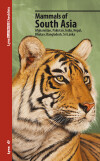
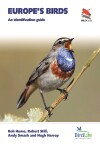
Dear Sir,
I’m from the Netherlands and next week my wive and I will be visiting Colorado to do the same trip around this state as you did.
We also hope to see the several species of Grouse. We made a reservation for the Greater Prairie Chicken tour and we do have enough information about leks for several other species (Lesser Prairie Chicken, Sharp-tailed Grouse and offcourse Gunnison Sage-grouse).
We however are not well informed about the Greater Sage-grouse. In your trip report I’ve read that you’ve seen this species on a lek along the CR-80. Is it possible that you give me more exact directions about this spot so we are able to see these great birds too? Thank you very much for your help.
Sjjaak, I just sent you an email with the location.
Hope your trip goes well!
[…] Birder’s Library, he shares one of his all-time favorite birding trips. Over a week spent in Colorado in April 2007 watching lekking grouse and other cool birds… what’s not to […]
I’m shutting down the comments on this post, since it’s getting alot of comment spam for some reason. If you have any questions or comments, please contact me here: http://www.birderslibrary.com/contact/